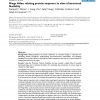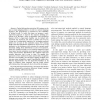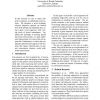133 search results - page 10 / 27 » Prediction of protease substrates using sequence and structu... |
BMCBI
2007
13 years 7 months ago
2007
Background: Relating features of protein sequences to structural hinges is important for identifying domain boundaries, understanding structure-function relationships, and designi...
ICASSP
2011
IEEE
12 years 11 months ago
2011
IEEE
Building models of the structure in musical signals raises the question of how to evaluate and compare different modeling approaches. One possibility is to use the model to impute...
BMCBI
2006
13 years 7 months ago
2006
Background: One-dimensional protein structures such as secondary structures or contact numbers are useful for three-dimensional structure prediction and helpful for intuitive unde...
ICDM
2009
IEEE
14 years 2 months ago
2009
IEEE
—Typical information extraction (IE) systems can be seen as tasks assigning labels to words in a natural language sequence. The performance is restricted by the availability of l...
EMNLP
2009
13 years 5 months ago
2009
In this research we aim to detect subjective sentences in multimodal conversations. We introduce a novel technique wherein subjective patterns are learned from both labeled and un...



